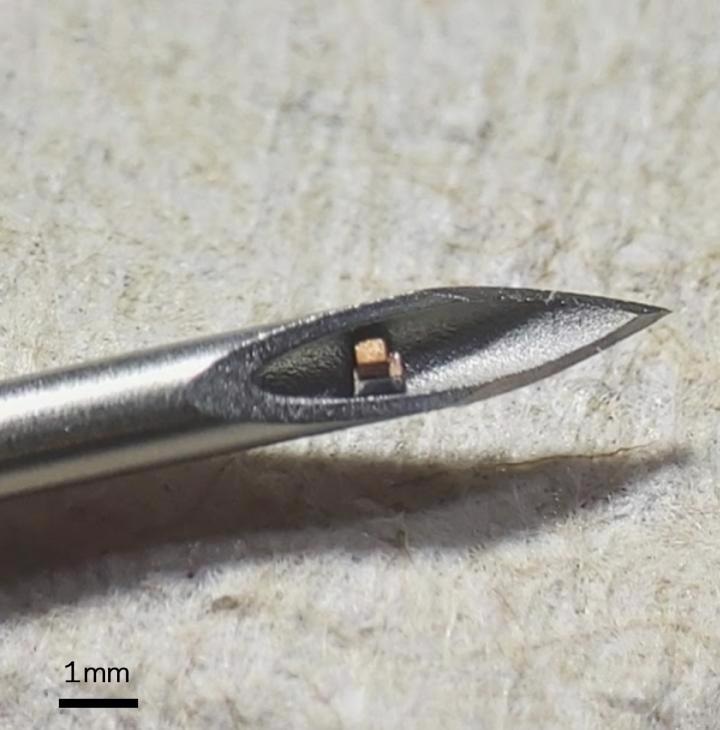May 12 2021
Implantable medical devices are extensively used to support and improve physiological functions, track and map biological signals, and treat various diseases. These devices are revolutionizing healthcare and enhancing the quality of life for scores of individuals.
 Chips are shown in the tip of a hypodermic needle. Columbia Engineers develop the smallest single-chip system that is a complete functioning electronic circuit; implantable chips visible only in a microscope point the way to developing chips that can be injected into the body with a hypodermic needle to monitor medical conditions. Image Credit: Chen Shi/Columbia Engineering.
Chips are shown in the tip of a hypodermic needle. Columbia Engineers develop the smallest single-chip system that is a complete functioning electronic circuit; implantable chips visible only in a microscope point the way to developing chips that can be injected into the body with a hypodermic needle to monitor medical conditions. Image Credit: Chen Shi/Columbia Engineering.
Scientists are increasingly keen on developing tiny, wireless implantable medical devices for in situ and in vivo physiological monitoring. Such devices could be used for tracking physiological conditions, like respiration, glucose, blood pressure, and temperature for both therapeutic and diagnostic procedures.
So far, traditional implanted electronics have been extremely inefficient in terms of volume—they usually demand numerous chips, external transducers, wires, and packaging, and besides this, batteries are generally required for storing energy.
A continuous trend in electronics has been the tighter incorporation of electronic parts, often moving increasing functions onto the integrated circuit itself.
Now, a research team from Columbia Engineering has claimed that they have fabricated the world’s tiniest single-chip system that uses a total volume of less than 0.1 mm3. The new system is as compact as a dust mite and can be seen only under a microscope.
To accomplish this feat, the researchers utilized ultrasound to both fuel and interact with the device wirelessly. The new study was published online in the Science Advances journal on May 7th, 2021.
We wanted to see how far we could push the limits on how small a functioning chip we could make. This is a new idea of ‘chip as system’—this is a chip that alone, with nothing else, is a complete functioning electronic system. This should be revolutionary for developing wireless, miniaturized implantable medical devices that can sense different things, be used in clinical applications, and eventually approved for human use.
Ken Shepard, Study Lead and Professor of Biomedical Engineering, Columbia University
Shepard is also the Lau Family professor of electrical engineering.
The researchers also included Elisa Konofagou, Robert and Margaret Hariri Professor of Biomedical Engineering and professor of radiology, and Stephen A. Lee, PhD student in the Konofagou laboratory who helped in the animal studies.
The novel design was made by Chen Shi, a doctoral student and the first author of the study. Shi’s design is special in its volumetric efficiency, the proportion of function contained in a specified amount of volume.
Conventional RF communications links are not feasible for such a small device because the wavelength of the electromagnetic wave is very large in relation to the device size.
The wavelengths for ultrasound are relatively smaller at a specified frequency because the speed of sound is extremely less when compared to the speed of light. Hence, the researchers utilized ultrasound to both power and interact with the device wirelessly. The team built the ‘antenna’ for powering and interacting with ultrasound directly above the chip.
The chip, which is the whole implantable/injectable mote without any extra packaging, was created at the Taiwan Semiconductor Manufacturing Company and more process modifications were carried out in the Columbia Nano Initiative cleanroom and the City University of New York Advanced Science Research Center (ASRC) Nanofabrication Facility.
This is a nice example of 'more than Moore' technology--we introduced new materials onto standard complementary metal-oxide-semiconductor to provide new function. In this case, we added piezoelectric materials directly onto the integrated circuit to transducer acoustic energy to electrical energy.
Ken Shepard, Study Lead and Professor of Biomedical Engineering, Columbia University
“Ultrasound is continuing to grow in clinical importance as new tools and techniques become available. This work continues this trend,” added Konofagou.
The objective of the researchers is to fabricate chips that can be administered into the body using a hypodermic needle and subsequently communicate back out of the body through ultrasound, offering data about something they quantify locally. While existing devices quantify body temperatures, the team is working on several more possibilities.
Journal Reference:
Shi, C., et al. (2021) Application of a sub-0.1-mm3 implantable mote for in vivo real-time wireless temperature sensing. Science Advances. doi.org/10.1126/sciadv.abf6312.